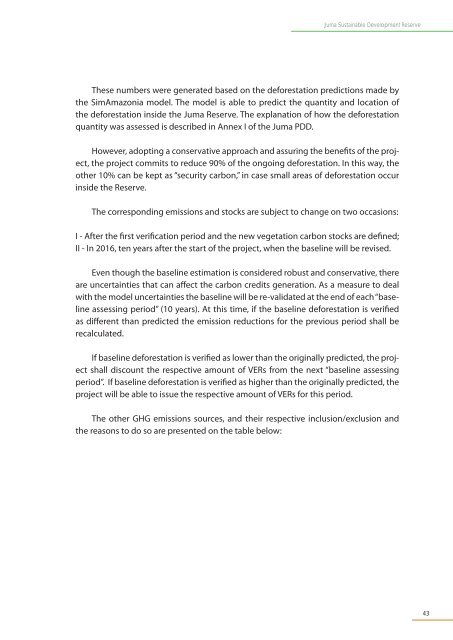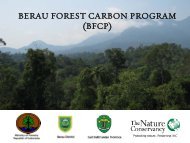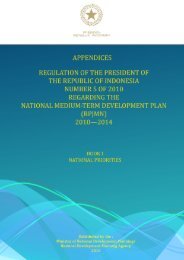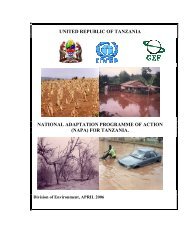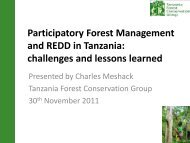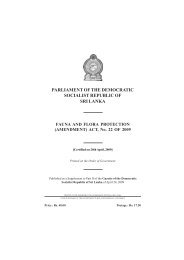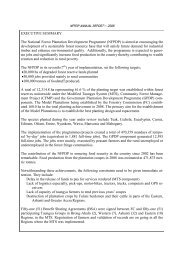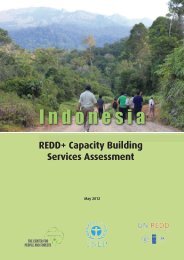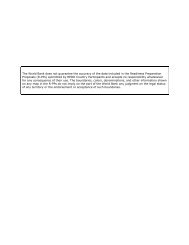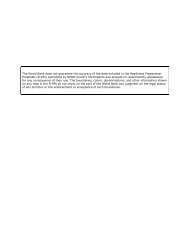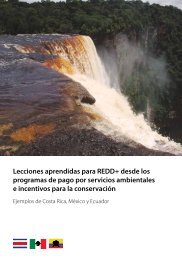Amazonas <strong>Sustainable</strong> Foundation Project year Carbon stocks C BASELINE C ACTUAL** C RED non CO2 GHG* Carbon stocks non CO2 GHG * Carbon stocks non CO2 GHG * annual cum anual cum annual cum annual cum annual cum annual cum Nr Yr tCO2e tCO2e tCO2e tCO2e tCO2e tCO2e tCO2e tCO2e tCO2e tCO2e tCO2e tCO2e 0 2006 0,00 0,00 0,00 0,00 28.157,65*** 28.157,65 1.858,41 1.858,41 -28.157,65 -28.157,65 -1.858,41 -1.858,41 1 2007 0,00 0,00 0,00 0,00 0,00 28.157,65 0,00 1.858,41 0,00 -28.157,65 0,00 -1.858,41 2 2008 0,00 0,00 0,00 0,00 0,00 28.157,65 0,00 1.858,41 0,00 -28.157,65 0,00 -1.858,41 3 2009 32.964,40 32.964,40 2.175,65 2.175,65 3.296,44 31.454,09 217,57 2.075,97 29.667,96 1.510,31 1.958,09 99,68 4 2010 3.782,80 36.747,20 249,66 2.425,32 378,28 31.832,37 24,97 2.100,94 3.404,52 4.914,83 224,70 324,38 5 2011 403.138,40 439.885,60 26.607,13 29.032,45 40.313,84 72.146,21 2.660,71 4.761,65 362.824,56 367.739,39 23.946,42 24.270,80 6 2012 85.383,20 525.268,80 5.635,29 34.667,74 8.538,32 80.684,53 563,53 5.325,18 76.844,88 444.584,27 5.071,76 29.342,56 7 2013 1.054.142,90 1.579.411,70 69.573,43 104.241,17 105.414,29 186.098,82 6.957,34 12.282,52 948.728,61 1.393.312,88 62.616,09 91.958,65 8 2014 537.573,75 2.116.985,45 35.479,87 139.721,04 53.757,38 239.856,20 3.547,99 15.830,51 483.816,38 1.877.129,25 31.931,88 123.890,53 9 2015 939.161,95 3.056.147,40 61.984,69 201.705,73 93.916,20 333.772,39 6.198,47 22.028,98 845.245,76 2.722.375,01 55.786,22 179.676,75 10 2016 1.157.988,45 4.214.135,85 76.427,24 278.132,97 115.798,85 449.571,24 7.642,72 29.671,70 1.042.189,61 3.764.564,61 68.784,51 248.461,26 11 2017 981.179,05 5.195.314,90 64.757,82 342.890,78 98.117,91 547.689,14 6.475,78 36.147,48 883.061,15 4.647.625,76 58.282,04 306.743,30 12 2018 1.908.132,70 7.103.447,60 125.936,76 468.827,54 190.813,27 738.502,41 12.593,68 48.741,16 1.717.319,43 6.364.945,19 113.343,08 420.086,38 13 2019 2.315.568,65 9.419.016,25 152.827,53 621.655,07 231.556,87 970.059,28 15.282,75 64.023,91 2.084.011,79 8.448.956,97 137.544,78 557.631,16 14 2020 3.326.513,10 12.745.529,35 219.549,86 841.204,94 332.651,31 1.302.710,59 21.954,99 85.978,90 2.993.861,79 11.442.818,76 197.594,88 755.226,04 15 2021 2.711.397,85 15.456.927,20 178.952,26 1.020.157,20 271.139,79 1.573.850,37 17.895,23 103.874,12 2.440.258,07 13.883.076,83 161.057,03 916.283,07 16 2022 4.158.774,45 19.615.701,65 274.479,11 1.294.636,31 415.877,45 1.989.727,82 27.447,91 131.322,04 3.742.897,01 17.625.973,83 247.031,20 1.163.314,27 17 2023 3.937.813,95 23.553.515,60 259.895,72 1.554.532,03 393.781,40 2.383.509,21 25.989,57 157.311,61 3.544.032,56 21.170.006,39 233.906,15 1.397.220,42 18 2024 3.920.166,15 27.473.681,75 258.730,97 1.813.263,00 392.016,62 2.775.525,83 25.873,10 183.184,70 3.528.149,54 24.698.155,92 232.857,87 1.630.078,29 19 2025 5.505.141,60 32.978.823,35 363.339,35 2.176.602,34 550.514,16 3.326.039,99 36.333,93 219.518,64 4.954.627,44 29.652.783,36 327.005,41 1.957.083,70 20 2026 4.077.651,35 37.056.474,70 269.124,99 2.445.727,33 407.765,14 3.733.805,12 26.912,50 246.431,14 3.669.886,22 33.322.669,58 242.212,49 2.199.296,19 21 2027 2.564.612,20 39.621.086,90 169.264,41 2.614.991,74 256.461,22 3.990.266,34 16.926,44 263.357,58 2.308.150,98 35.630.820,56 152.337,96 2.351.634,16 22 2028 3.244.232,25 42.865.319,15 214.119,33 2.829.111,06 324.423,23 4.314.689,57 21.411,93 284.769,51 2.919.809,03 38.550.629,58 192.707,40 2.544.341,55 23 2029 3.340.052,65 46.205.371,80 220.443,47 3.049.554,54 334.005,27 4.648.694,83 22.044,35 306.813,86 3.006.047,39 41.556.676,97 198.399,13 2.742.740,68 24 2030 9.004.620,15 55.209.991,95 594.304,93 3.643.859,47 900.462,02 5.549.156,85 59.430,49 366.244,35 8.104.158,14 49.660.835,10 534.874,44 3.277.615,12 25 2031 4.608.326,10 59.818.318,05 304.149,52 3.948.008,99 460.832,61 6.009.989,46 30.414,95 396.659,30 4.147.493,49 53.808.328,59 273.734,57 3.551.349,69 26 2032 5.098.646,40 64.916.964,45 336.510,66 4.284.519,65 509.864,64 6.519.854,10 33.651,07 430.310,37 4.588.781,76 58.397.110,35 302.859,60 3.854.209,28 27 2033 4.254.356,20 69.171.320,65 280.787,51 4.565.307,16 425.435,62 6.945.289,72 28.078,75 458.389,12 3.828.920,58 62.226.030,93 252.708,76 4.106.918,04 28 2034 0,00 69.171.320,65 0,00 4.565.307,16 0,00 6.945.289,72 0,00 458.389,12 0,00 62.226.030,93 0,00 4.106.918,04 29 2035 4.641.610,00 73.812.930,65 306.346,26 4.871.653,42 464.161,00 7.409.450,72 30.634,63 489.023,75 4.177.449,00 66.403.479,93 275.711,63 4.382.629,68 30 2036 8.889.921,25 82.702.851,90 586.734,80 5.458.388,23 888.992,13 8.298.442,84 58.673,48 547.697,23 8.000.929,13 74.404.409,06 528.061,32 4.910.691,00 31 2037 7.811.249,30 90.514.101,20 515.542,45 5.973.930,68 781.124,93 9.079.567,77 51.554,25 599.251,47 7.030.124,37 81.434.533,43 463.988,21 5.374.679,21 32 2038 8.264.573,90 98.778.675,10 545.461,88 6.519.392,56 826.457,39 9.906.025,16 54.546,19 653.797,66 7.438.116,51 88.872.649,94 490.915,69 5.865.594,90 33 2039 5.915.200,65 104.693.875,75 390.403,24 6.909.795,80 591.520,07 10.497.545,23 39.040,32 692.837,99 5.323.680,59 94.196.330,52 351.362,92 6.216.957,81 34 2040 4.597.403,70 109.291.279,45 303.428,64 7.213.224,44 459.740,37 10.957.285,60 30.342,86 723.180,85 4.137.663,33 98.333.993,85 273.085,78 6.490.043,59 35 2041 7.419.786,70 116.711.066,15 489.705,92 7.702.930,37 741.978,67 11.699.264,27 48.970,59 772.151,44 6.677.808,03 105.011.801,88 440.735,33 6.930.778,92 36 2042 7.098.568,20 123.809.634,35 468.505,50 8.171.435,87 709.856,82 12.409.121,09 46.850,55 819.001,99 6.388.711,38 111.400.513,26 421.654,95 7.352.433,88 37 2043 6.026.493,50 129.836.127,85 397.748,57 8.569.184,44 602.649,35 13.011.770,44 39.774,86 858.776,85 5.423.844,15 116.824.357,41 357.973,71 7.710.407,59 38 2044 5.973.481,05 135.809.608,90 394.249,75 8.963.434,19 597.348,11 13.609.118,54 39.424,97 898.201,82 5.376.132,95 122.200.490,36 354.824,77 8.065.232,36 39 2045 6.547.376,00 142.356.984,90 432.126,82 9.395.561,00 654.737,60 14.263.856,14 43.212,68 941.414,51 5.892.638,40 128.093.128,76 388.914,13 8.454.146,50 40 2046 8.118.717,20 150.475.702,10 535.835,34 9.931.396,34 811.871,72 15.075.727,86 53.583,53 994.998,04 7.306.845,48 135.399.974,24 482.251,80 8.936.398,30 41 2047 12.430.596,40 162.906.298,50 820.419,36 10.751.815,70 1.243.059,64 16.318.787,50 82.041,94 1.077.039,98 11.187.536,76 146.587.511,00 738.377,43 9.674.775,73 42 2048 10.071.494,00 172.977.792,50 664.718,60 11.416.534,31 1.007.149,40 17.325.936,90 66.471,86 1.143.511,84 9.064.344,60 155.651.855,60 598.246,74 10.273.022,47 43 2049 11.355.945,90 184.333.738,40 749.492,43 12.166.026,73 1.135.594,59 18.461.531,49 74.949,24 1.218.461,08 10.220.351,31 165.872.206,91 674.543,19 10.947.565,66 44 2050 13.495.158,75 197.828.897,15 890.680,48 13.056.707,21 1.349.515,88 19.811.047,37 89.068,05 1.307.529,13 12.145.642,88 178.017.849,78 801.612,43 11.749.178,09 Partial TOTAL TOTAL 197.828.897,15 Table 07 – Carbon and non CO2 GHG emissions for the <strong>Juma</strong> Project 210.885.604,4 13.056.707,21 19.811.047,37 1.307.529,13 178.017.849,78 11.749.178,09 21.118.576,5 189.767.027,9 *According to Fearnside, to obtain the CO2e value is needed additional adjustment for trace-gas effects of 6.6% relative to the impact of CO2 release alone (Fearnside, 1996) 42
<strong>Juma</strong> <strong>Sustainable</strong> <strong>Development</strong> <strong>Reserve</strong> <strong>The</strong>se numbers were generated based on the deforestation predictions made by the SimAmazonia model. <strong>The</strong> model is able to predict the quantity and location of the deforestation inside the <strong>Juma</strong> <strong>Reserve</strong>. <strong>The</strong> explanation of how the deforestation quantity was assessed is described in Annex I of the <strong>Juma</strong> PDD. However, adopting a conservative approach and assuring the benefi ts of the project, the project commits to reduce 90% of the ongoing deforestation. In this way, the other 10% can be kept as “security carbon,” in case small areas of deforestation occur inside the <strong>Reserve</strong>. <strong>The</strong> corresponding emissions and stocks are subject to change on two occasions: I - After the fi rst verifi cation period and the new vegetation carbon stocks are defi ned; II - In 2016, ten years after the start of the project, when the baseline will be revised. Even though the baseline estimation is considered robust and conservative, there are uncertainties that can aff ect the carbon credits generation. As a measure to deal with the model uncertainties the baseline will be re-validated at the end of each “baseline assessing period” (10 years). At this time, if the baseline deforestation is verifi ed as diff erent than predicted the emission reductions for the previous period shall be recalculated. If baseline deforestation is verifi ed as lower than the originally predicted, the project shall discount the respective amount of VERs from the next “baseline assessing period”. If baseline deforestation is verifi ed as higher than the originally predicted, the project will be able to issue the respective amount of VERs for this period. <strong>The</strong> other GHG emissions sources, and their respective inclusion/exclusion and the reasons to do so are presented on the table below: 43


